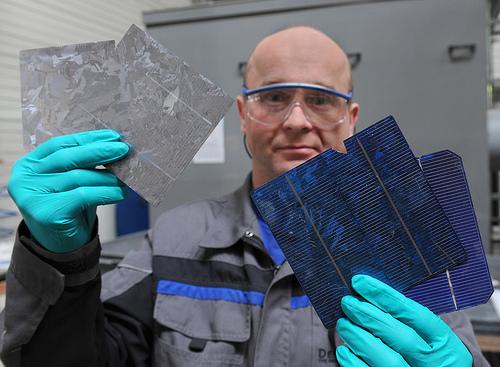CROSSCURRENTS
Written by Erica Gies
In recent years the electronics industry has gained notoriety for creating an endless stream of disposable products that make their way at life’s end to developing countries, where poor people without safety gear cut and burn out valuable materials, spilling contaminants into their water, air and lungs.
Solar modules contain some of the same potentially dangerous materials as electronics, including silicon tetrachloride, cadmium, selenium and sulfur hexafluoride, a potent greenhouse gas. So as solar moves from the fringe to the mainstream, insiders and watchdog groups are beginning to talk about producer responsibility and recycling in an attempt to sidestep the pitfalls of electronic waste and retain the industry’s green credibility.
Solar modules have an expected lifespan of at least 20 years so most have not yet reached the end of their useful lives. But now, before a significant number of dead panels pile up, is the perfect time to implement a responsible program, said Sheila Davis, executive director of the Silicon Valley Toxics Coalition.
The nonprofit environmental group has been a leader in recognizing the problems of e-waste, including hazardous disposal sites in the Bay Area left by the semiconductor industry. Now it is focused on the solar boom in Silicon Valley. Last year the group published a report calling for a “just and sustainable” solar industry, and this year it issued a scorecard of solar companies. The scorecard evaluates recycling and extended producer responsibility for the product’s end of life, called takeback; supply chain and green jobs; chemical use and lifecycle analysis; and disclosure.
Vastly expanding industry
Solar energy is the most widely available resource we have. Every hour, enough solar energy strikes Earth to meet human energy needs for more than a year, according to NASA. Now the solar industry is poised for huge growth in the United States, thanks to policy changes, incentives, technological improvements and economies of scale. Solar photovoltaics have recently become less expensive than nuclear energy on a per-kilowatt-hour basis, according to a new report from Duke University. Also, solar is widely expected to reach cost parity with fossil fuels in most markets by 2013.
In 2009, Greentech Media estimated that U.S. solar demand will continue to increase about 50 percent annually through 2012. The report said the U.S. capacity installed during 2008 was about 320 megawatts, and it predicted that about 2,000 megawatts would be installed during 2012. Such growth would put U.S. capacity ahead of solar leader Spain and potentially Germany as well.
While most of the new modules will likely have a long, productive life, factory scrap, transport breakages and field failures are ready for recycling now. Jennifer Woolwich is collecting these broken solar modules in a warehouse near Phoenix.
She founded her company PV Recycling in February 2009 after estimating that she could harvest 500 panels a week from these sources. She is not yet collecting at that capacity, nor does she have enough panels to begin recycling them, but she is talking with solar manufacturers in an effort to win their recycling business.
“Of those we interviewed, 100 percent want recycling,” she said. “Eighty percent want an independent third-party doing the recycling.”
Woolwich said she has seen a quick evolution in solar manufacturers’ attitudes toward recycling: “Last year, there was kind of a ‘wait and see, we’re not sure how this is going to work’ attitude. Over the past 12 months, I’ve seen a 180. I’ve seen companies who are hiring consultants to research their whole value chain to identify waste, including the end of life of modules. We’ve received calls from consumers asking us which companies have takeback programs in place.”
Solar companies tend to be secretive about their product recipes, making some manufacturers cautious about, yet conceptually open to, third-party recycling.
“We guarantee that intellectual property will not be put at risk,” Woolwich said. “We’re not interested in reverse engineering or selling company secrets. We have certificates of destruction that we [will] provide.”
For now, though, some companies are doing their own recycling.
SolarWorld, which received an 88 out of 100 on the toxics coalition’s scorecard, has been recycling its own panels since 2003 at its main factory in Freiberg, Germany. That factory now receives broken panels from its U.S. plants in Cabrillo, Calif., Hillsboro, Ore., and Vancouver, Wash.
“The fact is, there isn’t much to recycle,” said Ben Santarris, a spokesman for SolarWorld. “In the future we might expand recycling to our U.S. plants or contract with a third-party recycler.”
First Solar earned a rating of 67 on the scorecard. Headquartered in Tempe, Ariz., it has recycling facilities at its manufacturing sites in Perrysburg, Ohio; Frankfurt (Oder), Germany; and Kulim, Malaysia. Lisa Krueger, vice president of sustainable development, said that so far the company is primarily recycling manufacturing scrap.
“It’s our intention that there would be other recycling facilities worldwide as you get into those volumes,” she said.
…
View complete article (KALWNews.org): Solar Waste Recycling
About Crosscurrents
www.kalwnews.org
“Crosscurrents is the daily news magazine from KALW Public Radio, 91.7 FM in San Francisco. We are part of KALW’s Public Interest Reporting Project. KALW’s Public Interest Reporting Project began in 2003, with the goal of expanding local depth reporting, at a time when most news organizations were cutting back on public interest journalism. Since we began the project, much has changed in the media landscape: local outlets such as the San Francisco Chronicle, the San Jose Mercury News and CBS local news have suffered drastic cutbacks. These cuts signal that the commercial model for journalism is in crisis. We believe that public interest, non-profit media is one way to begin to fill that void, and that doing so is critical to public understanding and engagement.”
Tags: CA, California, Crosscurrents, Erica Gies, First Solar, Greentech Media, KALW, Photovoltaics, PV Recycling, San Francisco, Silicon Valley Toxics Coalition, Solar Energy, SolarWorld







 RSS Feed
RSS Feed